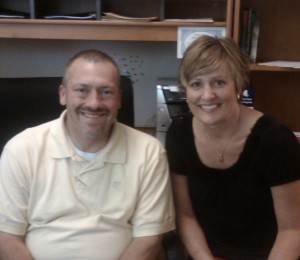I’m attending the NYSCATE conference in Rochester, arrived yesterday morning and leaving tomorrow afternoon. I’ve been coming to this conference about technology in education off and on for many years, the first of which was as a teacher for Pine Valley. Why do I come? To stretch my thinking, learn something new, talk with others who have similar interests. What am I leaving with? A renewed sense of commitment that we can do more and we can do it better.
I started yesterday as I expected, attending sessions that left me with notes like, “consider Fablevision’s Animation-ish for Mrs. Griffith, it looks better than the software she’s got; Starboard vs. Smartboard–what’s the cost? Any promos on quantity purchase?; check out more about Qwizdom as a flexible student response system; look at the Lumens document cameras, with a 5 yr. warranty, for Science teachers; ask if anyone is using Brainpop’s digital citizenship piece.”
That’s what I signed up for–ideas about smart technology. What I got next ramped this conference up considerably for me. Chris Lehmann. I’ve been reading Chris for at least three years, he’s the principal of Philadelphia’s Science Leadership Academy, a magnet school. When I started blogging in 2006, Chris was also out there writing and along with Christian Long we had some of the best conversations of my early blog learning. To finally meet Chris face to face reminded me why those conversations were so helpful to me.
I want to leave education when my time is done having done something important and meaningful that benefits our kids, our teachers and our community. I don’t think it’s my job to keep everything just as it’s always been–that’s how we will eventually become obsolete and I’m not game for sailing into retirement knowing I did nothing to change, that I didn’t lead our organization. We can do this better. Not that we aren’t doing it well, just that we can do it better. School can have more meaning and purpose for our students than it does now. And here’s why attending Chris Lehmann’s afternoon session and key note last night left my brain spinning early this morning. Chris talked about how they have made the entire learning experience different at Science Leadership Academy and on every point I thought, “why can’t we do that?” It wasn’t that he’s a magnet school and we’re not. It’s that they have a vision and goals and a plan–a system of student learning to which every member of the organization is committed, focused on, and working.
Too many people in our educational system are comfortable and happy with the way things are to the point that they don’t make anything better happen. As Chris said last night, then it’s all about them not the kids. And what did Chris say that I’m most considering? “It’s not about engagement. A TV show can be engaging. It’s about empowerment and meaningful work.”
From Wikipedia we can learn what the Science Leadership Academy is about and what they are committed to,
The Science Leadership Academy, or SLA, is a magnet high school in Philadelphia, Pennsylvania that opened in September 2006. The school is a partnership between The Franklin Institute and the School District of Philadelphia. SLA is a 1:1 laptop school where all students and teachers use Macintosh laptops as their primary learning tool. This is the first year with a full house of students, grades 9-12, with approximately 500 students in the school. The first class of seniors will graduate from the Science Leadership Academy in June 2010.
The Science Leadership Academy is an understanding-driven, project-based school where the learning is centered around the five core values of inquiry, research, collaboration, presentation and reflection. Students do benchmark projects every quarter to demonstrate the application of their learning.
In Spring 2009, SLA was named an Apple Distinguished School, one of only 33 schools in the nation with that distinction[1]. In addition, SLA was featured in the April 2007 Edutopia Magazine article, “My School, Meet MySpace” where the school is called “… [John] Dewey for the digital age, old-fashioned progressive education with a technological twist.”[2]
Inquiry, research, collaboration, presentation and reflection. Exactly what I hope my own kids will do well as adults. Empower my kid and give him meaningful work. He isn’t going to get anywhere in life by being a good test taker. Better yet, empower our kindergarten students and first graders and let’s give them those experiences all the way through–let’s make their education relevant and a part of their lives that they can’t wait to get to each day. I’m not saying we have to be SLA, but why can’t we be RCS, just better? Why can’t we give our kids meaningful work in our classrooms and empower them? Lots of our teachers are already doing that, from Kindergarten through the Senior year. We need more work as a system to make it happen consistently and with planning and for every child in every classroom. And that’s the same thing just about every other public school needs too. Let’s not wait for them. Let’s make it happen in Randolph.
And why is Randolph any different, why can we make it happen? Because we already do this better than any other public school district I’ve been in–our kids are learning in meaningful ways in classrooms throughout this district every day. Let’s plan for it to happen as a system.
Learning with Passion, Innovation and Leadership.

